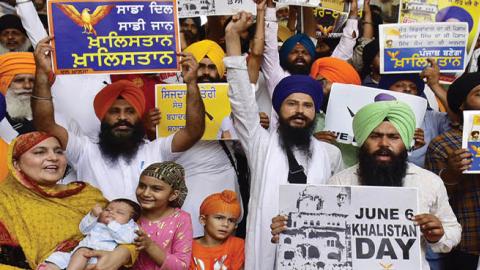Some in the US consider the global war on terrorism to have ended with the withdrawal of American troops from Afghanistan. But for its allies in Asia, especially India, terrorism remains front and center as a key concern. If Washington seeks Delhi’s support in countering Chinese aggression, Delhi needs American appreciation and support for the multitude of terrorism-related threats that India faces.
The most recent is the takeover of Afghanistan by the Taliban creating a vacuum that will be used by radical Islamist groups in the region, including those disrupting peace in Kashmir. While American policymakers occasionally speak of violence in Kashmir, they have largely ignored support for Khalistan, a separatist movement that instigated an extremely violent insurgency in Punjab for over a decade starting from the late 1970s.
Khalistani militants from among the vast Punjabi diaspora located in North America were responsible for terrorism, such as the 1985 bombing of an Air India transport plane, and allowing such militants to organise unchecked again could lead to tragedies again. While the domestic roots of Punjabi militancy are subject to scholarly debate, it is widely accepted that the movement received support from Pakistan’s security establishment, especially its Inter-Services Intelligence (ISI).
That support hasn’t stopped. A recent Hudson Institute report by Dr Christine Fair, Michael Rubin, Sam Westrop, Seth Oldmixon and others including myself examines the activities of US-based Khalistan groups, their links to pro-Pakistan Kashmiri separatist groups, and their ties to militant and terror groups based in India. It documents available evidence of support received by these US-based groups from entities and individuals linked to Pakistan.
Our investigation shows that Pakistan’s support for insurgent movements inside India dates to the 1950s, and is part of a strategy to exploit India’s religious, political, and ethnic fault lines. Maps of the original Khalistan movement included not just areas of present-day India but also large parts of present-day Pakistan that are religiously important to Sikhs. However, Khalistan groups seeking to curry favour with and funding from Pakistan now limit their territorial demands to the Indian state of Punjab. This is akin to those who demand a plebiscite in Indian Kashmir but say nothing about the parts of Kashmir currently controlled by Pakistan.
While Pakistan has shown reluctance to protect its own religious minorities, it has shown no compunction in using Sikh shrines on its side of the border to support the Khalistan cause. For example, the Evacuee Trust Property Board and the Pakistan Sikh Gurudwara Prabandhak Committee have been headed in the past by retired military or intelligence officers, indicating that they have been subsumed in Pakistan’s covert plans.
In 2018, India and Pakistan agreed to the opening of the Kartarpur corridor, a visa-free corridor between the two countries allowing Sikh pilgrims to visit holy shrines. An official Pakistani video during the opening ceremony, however, featured photos of three Khalistani separatist leaders killed by Indian forces during Operation Blue Star in 1984.
The Khalistan insurgency has no real support inside of India, but it still has support within some elements of the diaspora. In fact, the last few years have witnessed a rise in Khalistan-related anti-India activism within the US.
Our in-depth research showed Kashmiri and Khalistani activists operating in tandem across the US. In 2017 Khalistani and Kashmiri groups held joint protests in the US and again in August 2020, they jointly staged a demonstration. It is no coincidence that this increased activism is occurring at the same time as deepening strategic collaboration between the US and India to confront the rise of China. Pakistan, a critical Chinese ally, has a vested interest in weakening India’s close relations with the US. Acknowledging the strategic objective of mobilising rivals against the US and its primary South Asian ally, India, one of the most active Khalistan separatist groups in the US published open letters in 2020 to the leaders of Russia, China, and Pakistan requesting support for their cause.
Anticipation constitutes a crucial part of national security planning, and, therefore, the Hudson Institute report has called upon American law enforcement authorities to ensure that ostensibly peaceful pro-Khalistan activism does not become the precursor of a new wave of violence inside India.
With the first in-person leaders’ summit of the Quad (Australia, India, Japan, US) in Washington next week, it is important that the US takes India’s concerns related to Pakistan-backed terrorism seriously. Ignoring India’s concerns about threats to its integrity could undermine its resolve to act as America’s ally in confronting the aggressive intentions of Communist-led China, and this would constitute a significant and dangerous loss to the US.
Read in The Times of India















